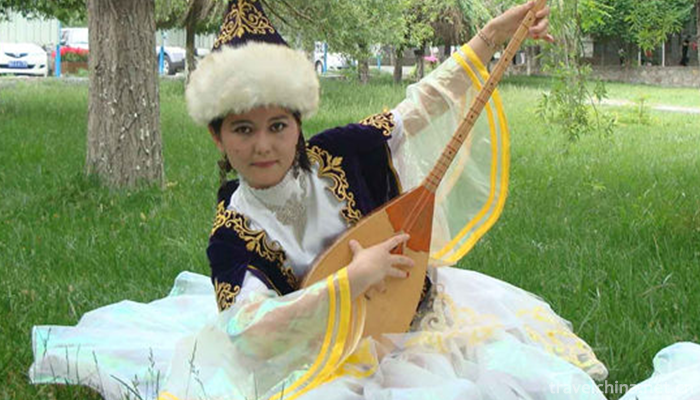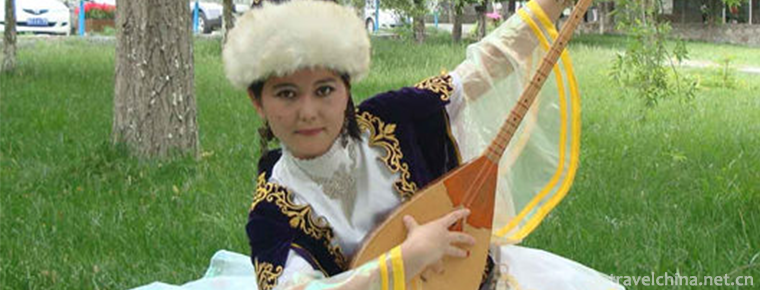Kazakhstan 62 Kwohner
Kazakhstan 62 Kwohner
62 Kwohner is Kazakh folk classical music, which means "62 suites". It is a comprehensive art mainly composed of instrumental music, accompanied by folk songs, dances, rap, playing and singing and other forms of artistic performance.
On June 7, 2008, 62 Kwohner of Kazakhstan was listed in the second batch of national intangible cultural heritage list with the approval of the State Council.
historical origin
Kazakhstan's 62-year-old Kuoen Er was formed in a specific time, because there was not enough historical literature to make a judgment. According to the research of modern scholars on 62 Kuoenl, it is believed that the formation and development of 62 Kuoenl should keep pace with the development of Kazakh music, especially the development of "Xiao". Generally speaking, it can be divided into the early form from Gusai to Wusun (early Han Dynasty), the gestation period from Wusun (Han Dynasty) to Kazakh Khanate (mid-Ming Dynasty), the formation period from Kazakh Khanate (mid-Ming Dynasty) to Qing Dynasty and the later evolution period.
With the social stability and economic development, culture and art have also been unprecedented prosperity. Especially since ancient times, folk stories, epics, music and dances that have been circulated in various tribes have been disseminated to each other under the condition of gradual unification of language and writing. At this time, a folk artist class club in the form of "Shale-Sell" appeared, which specializes in singing activities for a living. Many folk artists collect and organize songs, lyrics and dances that extol historical figures and national heroes, praise nature, animals (especially livestock raised), flowers and birds, describe people's feelings, praise pure love, reflect people's suffering and admonish the world.
After Kohan came to power in 1680, he attached great importance to the collection and collation of national cultural heritage. He organized a group of Kazakh folk Akans, genealogists, singers and knowledgeable elderly people to collect and collate Kazakh genealogy, music, proverbs, proverbs, myths and legends, historical stories, poems and epics of various subjects. At the same time, the slogans of Kazakh tribes were recorded comprehensively.
As Kazakhs live a nomadic life, in the four seasons of the year, the most convenient instruments to produce and carry are Dongbula, Spuzier and Kubuzi. These three instruments are most suitable for playing "Kuiyi" independently, so in folk music, "Kuiyi" is more widely spread and developed than other kinds of music.
artistic characteristics
Kazakhs call folk instrumental music "Kui Yi". Some of these "Kui Yi" are called "Kuo Ener". They either tell winding and moving stories or express the deep and sincere feelings of the performers. Their speed is generally slow andante, playing, do not show off skills but pay attention to charm. They let you understand the history of Kazakh people, insight into the soul of Kazakh people, feel the simple, honest, mellow and heavy music culture of grassland. Each piece of music will let you feel the unique beauty of traditional instrumental music of Kazakh people.
The three instruments of Dongbula, Kubuzi and Spuzier have their own characteristics: Dongbula can play a variety of techniques with left and right hands to produce a variety of tones; Kubuzi plays a simple and emotional melody; Spuzier is a simple and lasting long tone. This series of flowing music shows the unique musical aesthetic concept of Kazakhs. According to Kazakh scholars, in the ancient Kazakh grassland, the Kazakh people living in the West had "62 Akhjiling", whose music was fast and exciting; the Kazakh people living in the middle had "62 Kusbasar", whose music was gorgeous and beautiful; and the Chinese Kazakh people living in the East had "62 Kwaner", whose music was deep and moving. 。
Representative works
"Kaiesquauer", "Salequorner", "Telquorner", "Maydaquorn", "Akquorn" and so on
Inheritance significance
Owing to the lack of written records, geographical dispersion and inconvenience of transportation, there are not many people in Kazakhstan who can explain and sing for the public nowadays. The folk artists who can systematically sing "62 Kwon'er" are rare, and many excellent repertoires are facing extinction. Because of the social change, the change of production and life style and the challenge of globalization and modernization, the chain of inheritance of "62 Kwohner" is in danger of breaking down. There are not many young people who study folk music. Many of them have passed away, and many "Kwohner" music has been lost.


-
1.Shanghai
People's Republic of China municipality directly under the central government
Time 2018-10-12 -
2.Inner Mongolia Autonomous Region Alshan Chaihe Tourist Scenic Area
Inner Mongolia Autonomous Region Alshan Chaihe Tourist Scenic Area/Chaihe Tourist Scenic Spot has a total area of 1368.7 square kilometers
Time 2018-12-02 -
3.Zhongshan Zhan yuan
Zhanyuan is located in Beitai Village, South District of Zhongshan City, beside 105 National Highway, covering 100 mu. It is divided into three regions: Zhanyuan Zhushou, Qijiang Langqiao and Zhanfu Z
Time 2018-12-22 -
4.Heizhugou Scenic Area
Heizhugou National Forest Park, located in Heizhugou Town, Ebian Yi Autonomous County, Leshan City, Sichuan Province, spans Haqu Township, Lewu Township and Jinyan Township.
Time 2019-01-13 -
5.Hengdian Film and Television City Scenic Area
Hengdian Film and Television City is a large-scale comprehensive tourist area which integrates film and television, tourism, vacation, leisure and sightseeing. It has been rated as the national AAAAA-
Time 2019-01-13 -
6.Kunyu Mountain National Forest Park
Kunyushan National Forest Park is located in Mouping District, Yantai City, Shandong Province. It covers an area of 48 square kilometers and belongs to warm temperate monsoon
Time 2019-01-29 -
7.Nanping Opera
Nanping Opera is a folk art popular in the area of Jiuzhaigou County (former Nanping County) on the Northwest Plateau of Sichuan Province. It was once called "Nanping Pipa Playing and Singing&quo
Time 2019-06-07 -
8.New brown leaf weaving
Xinfang Brown edition is one of the traditional handicraft products in China. It has entered the third batch of national intangible cultural heritage list recommendation project list. It originated in
Time 2019-08-16 -
9.Cao Xiu
Cao Xiu(? - 228 years). Pei country Qiao (now Anhui Bozhou People. Three countries the Wei state of the Three-Kingdoms Period General, Cao Cao Clan.
Time 2019-09-15 -
10.Transportation in Panzhihua
By the end of 2018, Panzhihua had 3733.91 kilometers of grade roads and 195 kilometers of expressways. In the whole year, the highway passenger traffic volume was 20.79 million person times, the passenger turnover volume was 597.18 million person kilometers,
Time 2020-12-14 -
11.Topography and geomorphology of Luzhou
Luzhou city is a typical mountainous city with 56.14% of the total land area. It is mainly composed of high mountains (500-1000 meters above sea level) and middle mountain (1000-1902 meters above sea level). Taking the middle Yangtze River Valley as the lowest center, it gradually
Time 2020-12-14 -
12.Hydrology in Yibin
The water system in Yibin belongs to the external water system, with the Yangtze River as the main vein, with many rivers, high density and abundant water. Jinsha River and Minjiang River join to form the Yangtze River, which runs through the nor
Time 2020-12-18